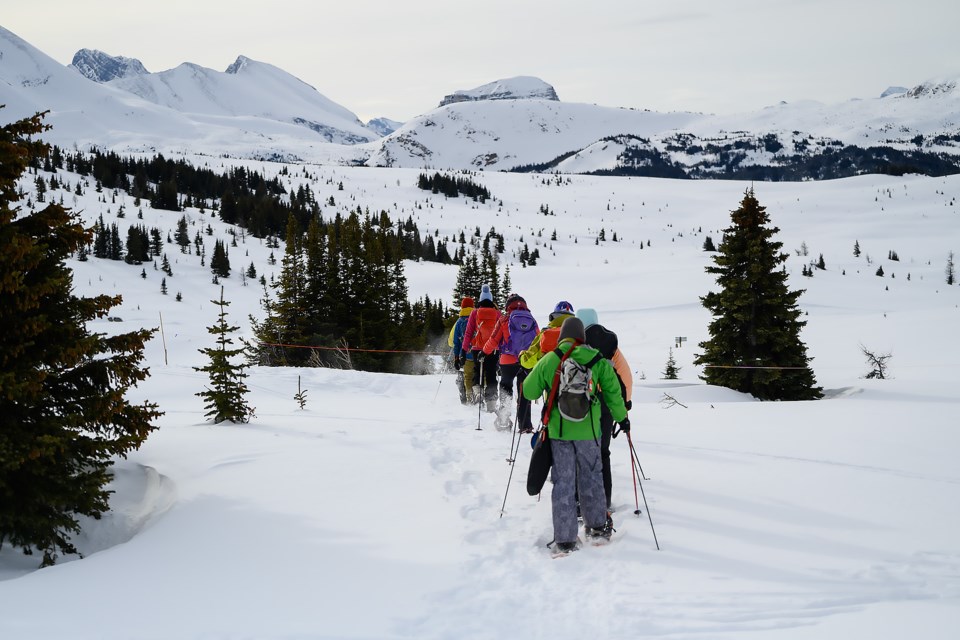A blank and icy white canvas awaits as Kim Asmussen straps on his snowshoes.
Using a compass and measuring tape, Asmussen takes the first step of what will be thousands to make sure every imprint is right where it’s supposed to be. Slowly but surely, what was once a design on the artist's phone starts to come to life.
The Schreiber, Ont. resident and snowshoe artist began his hobby of creating large pieces of landscape art on open fields and frozen lakes shortly before the world locked down for COVID-19.
“The driving force for me more now is just the enjoyment people get out of looking at it,” said Asmussen. “A lot of them are stuck inside in the wintertime and it’s sort of something neat to see."
On average, it takes between 300 to 400 feet in size using snowshoes to complete.
“You have to figure out how to do it, where you’re not walking, where you’re not supposed to walk, but that’s the trickiest part of it,” said Asmussen.
Along with mesmerizing patterns and lines, Asmussen has also designed a moose, a bald eagle, a nativity scene and intricate snowflakes back in Ontario.
Asmussen typically launches a drone to capture the final design, but because recreational drones are prohibited in Banff National Park, that part of the routine isn’t possible. In lieu, the top of Mount Standish and Lookout Mountain provide the top-down view needed to take in the full picture.
“At ground level you can see it, but it doesn’t have that same appeal as when you’re up higher,” said Asmussen.
Asmussen, also known as the Snowshoe Art Guy, draws inspiration for his art by seeing patterns and lines in places like a floor or in a carpet.
Once a pattern catches his eye, Asmussen puts a picture of the design in AutoCAD – a precision two and three-dimensional design software – where he can begin to scale it up and make measurements so that he has a template to bring to the snow.
“Quite often when I make a shape, I’m always developing new tools or jigs or whatever you want to call them, to do different things, to measure stuff or put parallel lines in,” said Asmussen.
Elevation is one piece to the puzzle for seeing the full perspective, but the other piece is Mother Nature. Conditions should ideally be sunny to make the depth of the snowshoe prints pop out from the landscape.
“If it’s cloudy or flat light, you might be able to see it, but it doesn’t have that same look as when the sun shines,” said Asmussen.
“Sometimes you might have to go two weeks before you can even do one because of the weather.”
Sure enough, the weather didn’t cooperate with Asmussen this time around.
On the final day, he and his volunteers caught some early morning sun before the clouds rolled in, making it near impossible to see from above. The snow then began to fall overnight filling in the thousands of steps taken by Asmussen and the helpers.
The next day, however, he made a small design to make up for Mother Nature’s bad mood.
Now that everything is ready to go all he needs is an open space full of snow, like the out-of-bounds meadows of Banff’s Sunshine Village, where he completed his latest piece on April 11.
It was a two-day project to complete his 860 by 530-foot design, which comprised 19 intersecting circles making the flower of life, a skier and snowboarder on either side, and Sunshine’s logo resting on top of it all.
“Sometimes there’s a story to the picture,” said Asmussen. “The gist of the story is either it’s a flower of life for the skiers who’ve lived on before us or a flower life because the skiers we have now have a life to ski. They can take either twist.”
Like with most of his snowy projects, Asmussen employs the help of eager volunteers to help pack down the design after he builds the framework. This around eight people came to help and had the design all packed and done before lunch time on the second day, leaving enough time to even catch a few turns at the resort.
“I try to get shape done ahead of time, and then the people come in and help pack," said Asmussen. "The neat thing is when they’re down on the ground, you don’t really have a grasp of what’s going on and then when you take the drone up after to get the picture, they’re just awestruck at what it looks like.”



